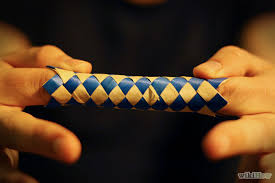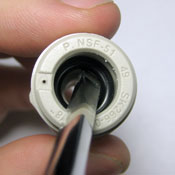Pure Water Annie’s FAQ Series
Pure Water Gazette Technical Wizard Pure Water Annie Answers All the Persistent Questions about Water Treatment.
This week’s topic: Quick Connect Fittings
Why do they call these things John Guest fittings?
The British company, John Guest, was the originator of the popular quick connect fittings used almost exclusively in small water filtration equipment these days. In the same way that all soft drinks are referred to as “cokes,” the brand name John Guest has become generic. Actually, there are several very good brands of “John Guest” fittings on the market.
How do they work?
When a piece of tubing is inserted into the fitting it passes through an o ring and is grabbed and held tightly in place by metal teeth that are mounted on a small collar called a collet. The tube is held tightly by the collet. Outward pressure makes the fitting tighter–something like a Chinese finger puzzle. It’s the small o ring that makes the seal. The metal teeth on the collet hold the tube in place. To release the tube, push in on the collet toward the body of the fitting and at the same time pull out the tube.
Do they leak?
Yes, but not often. They’re probably more reliable than standard threaded compression fittings because they aren’t as susceptible to installer error. Best of all, leaks are usually small drips–not the catastrophic blow-outs you can get with a poorly installed compression fitting.
What causes leaks?
New fittings seldom leak. Usually leaks occur after o rings in the fittings have been degraded by chemicals (chloramine is the worst) or by physical stress caused by improper placement. For example, if the installer fails to leave enough “slack” in a tube, causing the tube to be pulled hard to one side, a leak will usually occur because the o ring is flattened by physical stress. Fittings equipped with double o rings are less likely to leak than standard quick connects,
When the fitting leaks, can it be replaced?
Yes, it’s easy to replace fittings. There are many good brands on the market and they interchange well. But you really don’t have to replace leaking fittings because they are just as easily repaired. Replacing the o ring(s) almost always fixes the leak. Here’s a good article that tells how to fix them.
Once the collet has been popped out, the o ring is easy to remove and replace.
Sometimes they don’t release easily. Why?
If there’s any pressure at all on the fitting, it won’t release. You have to have the inlet water of your unit turned off an a downstream faucet open. And some fittings are harder to release than others. The double o ring variety–the ones that never leak–are also the hardest to release. Another of life’s tradeoffs.




![pwanniemedium[1]](http://www.purewatergazette.net/blog/wp-content/uploads/2012/05/pwanniemedium1-246x300.jpg)



